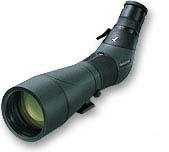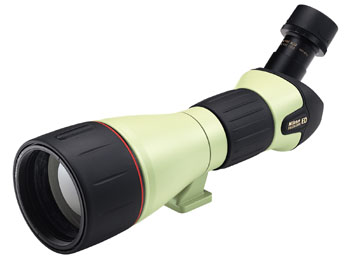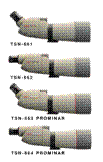Some Telescopes Compared
|
 |
LEICA Televid/APO 62 and 77
Quality speaks for itself. Probably the market leader and considered by many birders to be the best scopes available today. The entire range of scopes and eyepieces are suitable for digiscoping with still and video cameras. Both angled and straight eyepieces are available. The 77mm objective lens gives one of the brightest and sharpest images, even if it does make the scope a bit heavy.
Eyepieces -The three available eyepieces have a twist up/down eyecup, so do not have to be removed when digiscoping.
- 20x Excellent but perhaps a little low powered for general birding. Great results when used with a camcorder as it produces very little vignetting.
- 32x A very good eyepiece for all round use which although suitable for both still and video camera is really only recommended for still use.
- 20x - 60x A very popular choice for general birding and digiscoping, however it does lack the wide field of the previous two eyepieces.
|
SWAROVSKI AT80/HD is another contender for market leader and highly rated by birders as a popular choice for digiscoping. A robust design combined with superb performance has given this scope an excellent reputation.
Now replaced by the new ATS 80/HD with a substantial price difference. If you can find one, this older model still represents excellent value for money.
Eyepieces: four used to be available in the range but now only two. One slight drawback to the older design was the fold down rubber eyecup which needs to be removed before digiscoping. Both angled and straight eyepieces are available. The new eyepieces have easy to change eyecup which do not need to be removed.
- 30x A popular choice for general birding and ideal for use with still cameras.
- 20x - 60x a favourite eyepiece among some of the top digiscopers
Swarovski ATS, STS 65/80 is a new range of scopes offering the compact portability of the 65mm with the brilliant image of the 80mm. Weight has been reduced by a new robust aluminium housing encased in a rubberised armour. Great performance with all round colour fidelity and strong contrast rich images. The new eyepieces make them ideal for digiscoping.
Eyepieces: There are two eyepieces in this new range, both of which have now been fitted with a twist up/down eyecup so digiscoping is possible without having to remove the eyecup, but you will get slightly closer to the lens if you do.
- 30x ww A good field of view and bright image make this eyepiece very popular. This is an excellent choice for general birding.
- 20x - 60x What a stunning quality zoom! Excellent for digiscoping.
|
 |
 |
CARL ZEISS Diascope 65 & 85 T* FL is another top ranking scope from a market leader. Like the above this new scope from Zeiss gives superb optical clarity. Thanks to the Carl Zeiss Advanced Optics System, the compact, sturdy, low weight design and large ocular lens make these scopes ideal for digiscoping.
Eyepieces: There are three eyepieces in the range but due to differing focal lengths of the two scopes their magnification varies. While this is not a problem it does mean that a low powered eyepiece is currently not available for the 85mm scope.
- 23/30x is an excellent eyepiece giving a good crisp image and depth of field. While this is too powerful for camcorder use on the 85mm, it is fine on the 85mm.
- 30/40x is a quality fixed magnification eyepiece that performs well but is too powerful for general use on the 85mm.
- 15-45/20-60x. this eyepiece is probably the best choice for digiscoping as it has low magnification available for both models. Another good quality zoom from this top manufacturer.
|
NIKON Fieldscope EDIIIS/EDIIIA
Nikon optics have a fine reputation and this model has regained their premier position by waterproofing the highly regarded 60mm Fieldscope range.
This version combines the optical excellence of previous models with the compactness of a 60mm body. It makes an ideal companion for frequent travellers.
The 80mm gives that extra performance you would expect from a larger objective, and remains a benchmark scope for the serious birder and naturalist. However, unlike the 60mm, it is not fully waterproof.
Eyepieces: Nikon have a good range of eyepieces and yet again their magnification varies depending on which body is used. The newer range of eyepieces have the convenient twist up/down eyecup, whereas the older ones a fold down rubber version. While Nikon have recently introduced a new mount for their latest fieldscopes, it is easier to use the LCE adapter with the older design eyepieces.
- 24/30x delivers excellent quality with a crisp bright image on either body. Choose the right adapter and it good for digiscoping.
- 30/38x is a good choice for the 60mm but too powerful for general use with anything bigger.
- 20-45/28 - 56x recently upgraded it now has multi-coated lense. Optically very good but not ideal for digiscoping.
- 20-60/25 - 75x is the latest zoom from Nikon with slightly more magnification at the top end. A fine optic and can be used with a still camera.
|
 |
 |
OPTICRON ES 80:
A favourite choice in the mid price range with an 80mm objective lens, lightweight body and excellent optical quality.
Eyepieces: A good range of eyepieces are available to suit this scope, all of which have large eye lenses. For the best performance choose from the HDF range.
- 23xWW: Excellent eyepiece with twist up/down eyecup, ideal for still or video.
- 32xWW: Good magnification and field of view makes this the most popular eyepiece in the range. Only drawback is the eyecup needs to be removed for digiscoping.
- 20-60x: Excellent image quality with a good zoom range, but again the rubber eyecup needs to be removed for digiscoping.
|
 |
Opticron HR66/ED:
Highly recommended award winning optical quality has made these scopes a popular choice for many years. The light gathering ability of the 80mm objective lens is better than the 66mm lens, and although these scopes take the same eyepieces as the ES 80 the magnification will vary.
Both straight and angled versions are available.
Excellent eyepieces across the HDF range
|
 |
Opticron Imagic 80:
A popular budget scope that performs well with the standard eyepieces. To enhance the quality still further choose from the full range of HDF eyepieces. While the optical quality of these scopes is not as good as more expensive models, for digiscoping it produces adequate results. |
Kowa TS610 Series
A popular compact range of scopes that is a favourite amongst birders. Its lightweight body and good optical quality make it a good choice.
Eyepieces: To provide the best optical quality with this scope many birders are using the old TSN 30xw eyepiece which seems to work better for digiscoping. The zoom lenses are adequate for general viewing but not recommended for digiscoping.
- TS 20x performs well but is not ideally suited to digiscoping.
- TS 27x is the most popular eyepiece for this range of scopes but is not ideal.
- TS 20-40x is the best of these two zooms, a good performer but not recommended.
- TS 20-60x is not very highly rated.
|
 |
Kowa TS660 series is a new series proving to be very popular with birdwatchers with its increased light gathering and optical improvements it is worth a look. The extra 6mm on the objective lens does give it a slightly brighter image, whilst still maintaining the compactness of the 610 series.
Eyepieces: These scopes utilise the TSN range of eyepieces and compliment the increased performance of the body. The rubber eyecups will need to be removed for digiscoping.
- TSN 20x: Excellent performance, good depth of field and bright image, ideal for use with a camcorder.
- TSN 30x: One of the first 30x wide angle’s on the market, this eyepiece still continues to sell well, ideal with a still camera.
- TSN 20-60x: Doesn’t live up to the performance of the previous two eyepieces, can be used for digiscoping but stick to the lower magnifications.
|
 |
Kowa TSN 1/2/3/4:
Now a discontinued range these were once the best selling scopes on the market. The 77mm objective and the good quality optics made it the birders favourite.
If you can find a one they are usually a real bargain second hand.
Eyepieces: Uses the same eyepieces that fit on the TS 660 series.
|
|
Kowa 820 series:
These are quality scopes with a lightweight construction for its size with an 82mm objective lens. Optical performance and ease of use make it a popular choice even if the prism housing is a bit bulky.
Eyepieces: The range has all been updated and perform well. Although there is no fixed 20x eyepiece the others offer good performance. For digiscoping the rubber eyecups will need to be removed.
- TSN 32x: A good wide angle view with good general magnification makes this eyepiece ideal for use with a still camera.
- TSN 50x: Despite being a high magnification rather than general use eyepiece, this is a popular choice. The option of the extra magnification with a relatively wide field of view makes it a good choice, especially with a still camera.
- TSN 20-60x: One of the best available. Gives the usual range of magnification associated with a zoom but with excellent performance.
|
 |
| Back to top |
|
|
| |
| |
| |
|
|
| |
|
|

